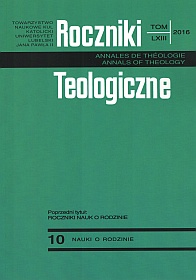Theological Foundation of Administrative Canon Law
Abstract
Prior to Vatican Council II there has been a dominant ecclesiology which looked at the Church as an institution. “that is to say, the view that defines the Church primarily in terms of its visible structures, especially the rights and powers of its officers.” With the coming of Vatican II, the Church is defined “in the nature of sacrament—a sign and instrument that is of communion with God and of unity among all men.” The principal paradigm of the Church in the documents of Vatican Council II is that of ”the people of God... The Church is seen as a community of persons each of whom is individually free.” It is with this view of the Church as a circle of friends and not a hierarchical pyramid that we shall explain the theological foundation of Administration Canon Law in the Code of 1983.
References
Benedict XVI. Encyclical letter Deus Carita Est. Nairobi: Paulines Publications Africa, 2005.
Benedict XVI. Encyclical letter Spe Salvi. Nairobi: Paulines Publications Africa, 2007.
Bishops of England and Wales. A Catechism of Doctrine. London: Catholic Truth Society, 1985.
Flannery, Austin (ed). Vatican Council II: The Conciliar and Post Conciliar Documents. Nairobi: Dominican Publications Africa, 1995.
John Paul II. Exhortation Ecclesia in Africa. Nairobi: Paulines Publications Africa, 1995.
Pius XI, “Encyclical Letter Quadragesimo Anno.” In Claudia Carlen (ed.). The Papal Encyclicals 1903–1939, 415–443. Raligh: the Pierian Press, 1990.
The Canon Law society of Great Britain and Ireland. The code of Canon Law in English Translation. London: Collins Liturgical Publications, 1983.
The Catechism of the Catholic Church. Nairobi: Pauline Publications Africa, 2007.
Zimbabwe Catholic Bishops Conference. National Pastoral Directory. Harare: Kolbe Press, 1998.
Alesandro, John A. “General Introduction.” In James A. Coriden, Thomas J. Green, and Donald E. Heintschel (eds.). The code of Canon Law: A Text and Commentary, 1–22. New York, Mahwah, NJ: Paulist Pres, 1985.
Arrieta, Juan Ignacio. Governance Structures within the Catholic Church. Milan: Wilson and Lafleur, 2000.
Davis, Charles. Theology for Today. New York: Sheed and Ward, 1962.
De Lubac, Henri. Catholicism. London: Burns and Oats and Westbourne, 1950.
Dulles, Avery. Models of the Church. New York: Doubleday and Company, 1978.
Guralnik, David B., et al (eds.). Webster’s New World Dictionary of American Language. New York: The World Publishing Company, 1956.
Kaslyn, Robert J. “Baptism as Basis for Church Ministry: Application of Ecclesiology of Communio.” The Jurist 60 (2000): 310 –329.
Massaro, Thomas, and Richard E. Mullahy. “Subsidiary.” In New Catholic Encyclopaedia, Vol. 13, 567–569. Washington: The Catholic University of America, 2003.
Morrissey, Francis G. Sanctions in the Law of the Church. Nyahururu: Canon Law Society of Kenya, Tabor Hill Pastoral Centre, 2005, Convention.
Sheed, Frank J. Theology and Sanity. New York: Sheed and Ward, 1946.
Wermter, Oscar. Politics for Everyone and by Everyone: A Christian Approach. Nairobi: Paulines Publications Africa, 2005.
Copyright (c) 2016 Roczniki Teologiczne

This work is licensed under a Creative Commons Attribution-NonCommercial-NoDerivatives 4.0 International License.





